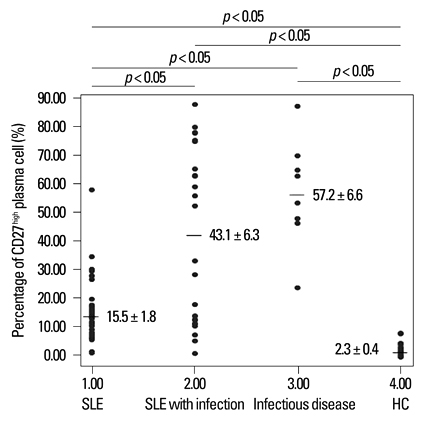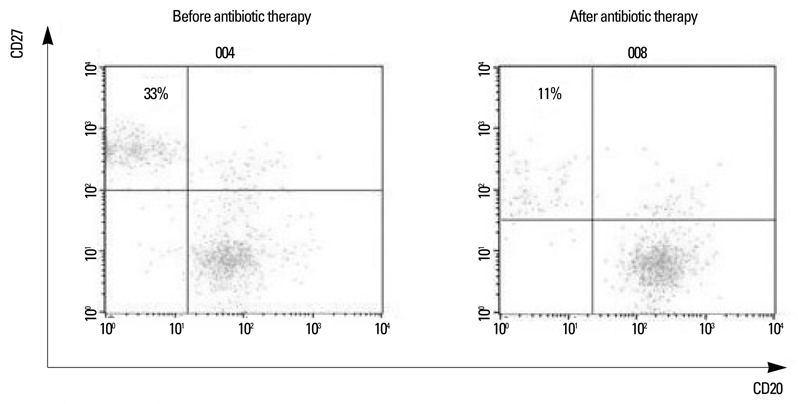Yonsei Med J.
2010 Nov;51(6):924-931. 10.3349/ymj.2010.51.6.924.
Significantly Higher Percentage of Circulating CD27(high) Plasma Cells in Systemic Lupus Erythematosus Patients with Infection than with Disease Flare-Up
- Affiliations
-
- 1Division of Rheumatology/Immunology/Allergy, Department of Internal Medicine, Armed-Forces Taichung General Hospital, Taichung, Taiwan, Republic of China.
- 2Division of Rheumatology/Immunology/Allergy, Department of Internal Medicine, Tri-Service General Hospital, National Defense Medical Center, Taipei, Taiwan, Republic of China. deng6263@ms71.hinet.net
- 3Graduate Institute of Life Sciences, National Defense Medical Center, Taipei, Taiwan, Republic of China.
- KMID: 1779641
- DOI: http://doi.org/10.3349/ymj.2010.51.6.924
Abstract
- PURPOSE
To distinguish lupus flare-up from infection in systemic lupus erythematosus (SLE), we analyze the expression of circulating CD27(high) plasma cells in SLE patients with and without infection, in comparison to non-SLE patients with infection.
MATERIALS AND METHODS
The percentage of circulating CD27(high) plasma cells was measured by flow cytometry in the following four groups: 36 SLE patients without infection, 23 SLE patients with infection, eight non-SLE patients with infection, and 26 healthy controls.
RESULTS
The frequency of CD27(high) plasma cells had a correlation with the SLE disease activity index (SLEDAI) (r = 0.866, p < 0.05), level of anti-dsDNA (r = 0.886, p < 0.05), C3 (r = - 0.392, p < 0.05), and C4 (r = - 0.337, p < 0.05) in SLE patients without infection, but there was no correlation with disease activity in SLE patients with infection. Among three groups in particular-SLE without infection, SLE with infection, and non-SLE with infection-the percentages of CD27(high) plasma cells were elevated. The percentage of CD27(high) plasma cells was higher in SLE patients with infection, when compared to SLE patients without infection.
CONCLUSION
The percentage of CD27(high) plasma cells is a biomarker for disease activity of SLE without infection, under correlation with SLEDAI, anti-dsDNA, and C3 and C4 level. However, when the SLE patients have an infection, the percentage of CD27(high) plasma cells is not an adequate biomarker for the survey of disease activity. The percentage of CD27(high) plasma cells may serve as a potential parameter to distinguish a lupus flare-up from infection.
Keyword
MeSH Terms
Figure
Reference
-
1. Chan OT, Madaio MP, Shlomchik MJ. The central and multiple roles of B cells in lupus pathogenesis. Immunol Rev. 1999. 169:107–121.
Article2. Lipsky PE. Systemic lupus erythematosus: an autoimmune disease of B cell hyperactivity. Nat Immunol. 2001. 2:764–766.
Article3. Odendahl M, Jacobi A, Hansen A, Feist E, Hiepe F, Burmester GR, et al. Disturbed peripheral B lymphocyte homeostasis in systemic lupus erythematosus. J Immunol. 2000. 165:5970–5979.
Article4. Wei C, Anolik J, Cappione A, Zheng B, Pugh-Bernard A, Brooks J, et al. A new population of cells lacking expression of CD27 represents a notable component of the B cell memory compartment in systemic lupus erythematosus. J Immunol. 2007. 178:6624–6633.
Article5. Jacobi AM, Reiter K, Mackay M, Aranow C, Hiepe F, Radbruch A, et al. Activated memory B cell subsets correlate with disease activity in systemic lupus erythematosus: delineation by expression of CD27, IgD, and CD95. Arthritis Rheum. 2008. 58:1762–1773.
Article6. Han BK, White AM, Dao KH, Karp DR, Wakeland EK, Davis LS. Increased prevalence of activated CD70+ CD4+ T cells in the periphery of patients with systemic lupus erythematosus. Lupus. 2005. 14:598–606.
Article7. Dolff S, Wilde B, Patschan S, Dürig J, Specker C, Philipp T, et al. Peripheral circulating activated b-cell populations are associated with nephritis and disease activity in patients with systemic lupus erythematosus. Scand J Immunol. 2007. 66:584–590.
Article8. Liu CC, Ahearn JM. The search for lupus biomarkers. Best Pract Res Clin Rheumatol. 2009. 23:507–523.
Article9. Yang DH, Chang DM, Lai JH, Lin FH, Chen CH. Usefulness of erythrocyte-bound C4d as a biomarker to predict disease activity in patients with systemic lupus erythematosus. Rheumatology (Oxford). 2009. 48:1083–1087.
Article10. Jacobi AM, Odendahl M, Reiter K, Bruns A, Burmester GR, Radbruch A, et al. Correlation between circulating CD27 high plasma cells and disease activity in patients with systemic lupus erythematosus. Arthritis Rheum. 2003. 48:1332–1342.
Article11. Dörner T, Lipsky PE. Correlation of circulating CD27 high plasma cells and disease activity in systemic lupus erythematosus. Lupus. 2004. 13:283–289.12. Ten Boekel E, Siegert CE, Vrielink GJ, Van Dam VC, Ceelen A, De Kieviet W. Analyses of CD27++ plasma cells in peripheral blood from patients with bacterial infections and patients with serum antinuclear antibodies. J Clin Immunol. 2007. 27:467–476.
Article13. Suh CH, Jeong YS, Park HC, Lee CH, Lee J, Song CH, et al. Risk factors for infection and role of C-reactive protein in Korean patients with systemic lupus erythematosus. Clin Exp Rheumatol. 2001. 19:191–194.14. ter Borg EJ, Horst G, Limburg PC, van Rijswijk MH, Kallenberg CG. C-reactive protein levels during disease exacerbations and infections in systemic lupus erythematosus: a prospective longitudinal study. J Rheumatol. 1990. 17:1642–1648.15. Fritsch RD, Shen X, Illei GG, Yarboro CH, Prussin C, Hathcock KS, et al. Abnormal differentiation of memory T cells in systemic lupus erythematosus. Arthritis Rheum. 2006. 54:2184–2197.
Article16. Swaak AJ, Hintzen RQ, Huysen V, van den Brink HG, Smeenk JT. Serum levels of soluble forms of T cell activation antigens CD27 and CD25 in systemic lupus erythematosus in relation with lymphocytes count and disease course. Clin Rheumatol. 1995. 14:293–300.
Article17. Font J, Pallares L, Martorell J, Martinez E, Gaya A, Vives J, et al. Elevated soluble CD27 levels in serum of patients with systemic lupus erythematosus. Clin Immunol Immunopathol. 1996. 81:239–243.
Article18. Carter RH. B cells in health and disease. Mayo Clin Proc. 2006. 81:377–384.
Article19. Agematsu K, Hokibara S, Nagumo H, Komiyama A. CD27: a memory B-cell marker. Immunol Today. 2000. 21:204–206.
Article20. Cervera R, Khamashta MA, Font J, Sebastiani GD, Gil A, Lavilla P, et al. Morbidity and mortality in systemic lupus erythematosus during a 10-year period: a comparison of early and late manifestations in a cohort of 1,000 patients. Medicine (Baltimore). 2003. 82:299–308.
Article21. Roy S, Tan KT. Pyrexia and normal C-reactive protein (CRP) in patients with systemic lupus erythematosus: always consider the possibility of infection in febrile patients with systemic lupus erythematosus regardless of CRP levels. Rheumatology (Oxford). 2001. 40:349–350.
Article22. Williams RC Jr, Harmon ME, Burlingame R, Du Clos TW. Studies of serum C-reactive protein in systemic lupus erythematosus. J Rheumatol. 2005. 32:454–461.23. Hellmich B, Csernok E, de Haas M, von dem Borne AE, Schatz H, Gross WL, et al. Low Fcgamma receptor III and high granulocyte colony-stimulating factor serum levels correlate with the risk of infection in neutropenia due to Felty's syndrome or systemic lupus erythematosus. Am J Med. 2002. 113:134–139.
Article24. Egerer K, Feist E, Rohr U, Pruss A, Burmester GR, Dörner T. Increased serum soluble CD14, ICAM-1 and E-selectin correlate with disease activity and prognosis in systemic lupus erythematosus. Lupus. 2000. 9:614–621.25. Zandman-Goddard G, Shoenfeld Y. Infections and SLE. Autoimmunity. 2005. 38:473–485.26. Bosch X, Guilabert A, Pallarés L, Cerveral R, Ramos-Casals M, Bové A, et al. Infections in systemic lupus erythematosus: a prospective and controlled study of 110 patients. Lupus. 2006. 15:584–589.
Article27. Zandman-Goddard G, Shoenfeld Y. SLE and infections. Clin Rev Allergy Immunol. 2003. 25:29–40.
Article28. Gladman DD, Hussain F, Ibañez D, Urowitz MB. The nature and outcome of infection in systemic lupus erythematosus. Lupus. 2002. 11:234–239.
Article
- Full Text Links
- Actions
-
Cited
- CITED
-
- Close
- Share
- Similar articles
-
- Infection in systemic lupus erythematosus, similarities, and differences with lupus flare
- The Presence of Anti-ribonucleoprotein at Diagnosis Is Associated with the Flare during the First Follow-up Year in Korean Patients with Systemic Lupus Erythematosus
- A Case Of Systemic Lupus Erythematosus Associated With Hyperthyroidism And Severe Retinopathy
- A Case of Lupus Enteritis That Developed during the Treatment of Systemic Lupus Erythematosus
- Circulating Interleukin-37 Levels in Rheumatoid Arthritis and Systemic Lupus Erythematosus and Their Correlations With Disease Activity: A Meta-analysis




